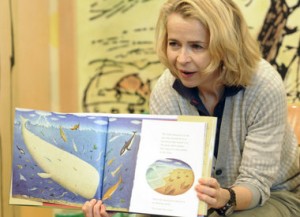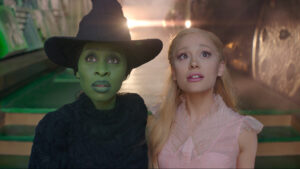Sally Lloyd-Jones, author of the bestselling Jesus Storybook Bible, never wanted to write a children’s Bible.
But after a year of struggling to find work as a children’s author, she wasn’t in the financial position to turn down Christian publisher Zondervan when they asked for a new Bible.
“I needed the money,” she said.
So Lloyd-Jones started in on a story Bible that would take three years of work and a mountain of editorial challenges. Gradually, she fell in love with it, and so did everyone else. Over the last decade, The Jesus Storybook Bible has sold 2.5 million copies, been translated into 33 languages, and spun off an audio and video version, a curriculum, and an adult book. The book has picked up multiple awards and has been given 4.9 stars by more than 3,000 Amazon reviewers.
This March, The Jesus Storybook Bible turns 10, and Lloyd-Jones is celebrating by kicking off a stories and songs concert tour with Amy Grant and Compassion International.
Catching Fire
The Jesus Storybook Bible, which is often given at baby showers or baptisms, has a fascinating birth story of its own.
Lloyd-Jones started somewhat reluctantly, prepared to do a good job and then get on to the next thing.
“I’m four months into researching it, and I went to a party with a friend,” Lloyd-Jones said. “A friend’s husband . . . told me the story of Martin Luther translating the Bible into German. He said Luther’s advice was not to go into the academy to listen to how the professors spoke; instead, go into a home and listen to a mother speaking to her children.”
Lloyd-Jones was hooked. “I had a narrator,” she said. “I started writing like a mother speaking to her child.”
That voice allowed her to put in quirky lines. For example, after God confused the languages at the Tower of Babel, Lloyd-Jones wrote, “You could be saying something like ‘Such a lovely morning!’ and then get a punch in the nose because they thought you said, ‘Hush up, you’re boring!’”
Having a narrator also let her end each story with a glimpse of what is to come (“I love cliffhangers”).
She listened to the sermons of Tim Keller and Martin Lloyd-Jones—“No relation; it’s a fairly common name in Wales”—and took a course on progressive revelation, the idea that God reveals himself in Scripture to humanity over time.
But it was C. S. Lewis who finally flipped the switch for Lloyd-Jones.
“I thought, What would C. S. Lewis do if he had to write a children’s Bible?” she said. “The Holy Spirit used that. Before, I knew I would do a great job. But after, [the vision was] something that was given to me. My imagination caught on fire. At that point, I had to give it everything I could, no matter how long it took.”
No longer reluctant, Lloyd-Jones threw herself into the work.
Battles
Getting the words on the page was only half the battle.
“Back then, I was unknown, and I had no power,” Lloyd-Jones said. She turned in her manuscript to Zondervan, but it wasn’t greeted enthusiastically. The book broke the mold in many ways, and both Lloyd-Jones and also her publisher wrestled with how to move it forward.
“They questioned everything,” she said. One big sticking point: the sentence fragments.
The Jesus Storybook Bible was written to be read aloud; the language on the pages includes phrases such as “Nothing to hear. Nothing to feel. Nothing to see.”
The publishing team told her to change them to complete sentences, so she did. Until a friend said, “It’s not going to work. It’s turning into a big mess.”
Lloyd-Jones insisted on her fragments.
Another debate came over the illustrator. Lloyd-Jones, who majored in art history and worked with illustrators in previous jobs, had a vision for how the book needed to look.
Zondervan overrode her and picked an artist, who had to turn the project down for health reasons. Then they overrode her and picked a second artist, but the sales department rejected that one.
Finally, everyone headed back to the drawing board.
Lloyd-Jones had her eye on Jago, a children’s book illustrator from Cornwall, England, with a pile of awards of his own. She remembers sitting in a meeting, looking at a table full of “brown-looking, old-fashioned art” where Jago’s work was “a bright spot.”
She was silent, worried that voicing her opinion (again) would turn the tide against her. But then a young designer said, “I think Jago is right for this.”
“They all listened to her!” Lloyd-Jones said. “I was thrilled.”
The team asked Jago for samples, then talked among themselves about how they’d like an unscrolled parchment to be the illustration on the first page, and how a dotted or dashed spiral could represent the promise of blessing.
When Jago’s samples arrived, the first page showed hands holding a manuscript. He had illustrated blessings with—you guessed it—pale swirls.
“The editor said, ‘Well, I don’t know how many more clues God has to give us to pick Jago.’”
Lloyd-Jones credits much of the book’s success to the illustrator, whose depictions of Jesus are “fresh and multiracial and so perfect.”
Then, about five years ago, a director at Zondervan told Lloyd-Jones he was sorry for the resistance they put up. “He said, ‘I need to apologize to you, because you knew what we had before we did,’” Lloyd-Jones said. “I thought that was an incredible thing. I don’t know any publishers who do that.”
“If the Lord hadn’t been in charge, the book would never have come out. All the pieces had to work together.”
Never-Ending Love
One of Lloyd-Jones’s best-known lines from the book is the repeated description of God’s“never ending, never giving up, unbreaking, always and forever love.”
It’s a line meant to counter the weight of expectation that Sunday school and children’s Bibles can sometimes put on children, Lloyd-Jones said.
“When I was 6, I went to a Sunday school where I got the idea that it was all rules and coloring inside the lines,” she said. “I hated it. I remember walking to church holding my dad’s hand, and from the outside we looked lovely, but inside I was making a vow that when I grew up, I was never going to church again.”
When an editor suggested she add the story of Jesus in the temple as a boy, with the moral to obey your parents, Lloyd-Jones “had a reaction like a tiger with her cub: ‘I will not allow that in this Bible.’”
“If the Bible tells you all the things you have to do right, and I’m not doing it right, God can’t be pleased with me,” Lloyd-Jones explains her 6-year-old reasoning. “When I go to churches and schools and say, ‘How many people here think you have to be good for God to love you?’ they’re raising their hands. These are children who know the Bible stories.”
It’s the weight given to God’s love that has caused the relatively small amount of criticism for The Jesus Storybook Bible.
 The book “emphasizes the primacy of God’s love in an imbalanced manner,” New Testament professor Charles Lee Irons wrote. “[B]y completely avoiding God’s judgment and by putting a deliberate emphasis on God’s love for his children ‘no matter what,’ Lloyd-Jones distorts the character of God in a way that, in the end, makes it logically impossible to believe that he is a God of holiness, wrath, or judgment.”
The book “emphasizes the primacy of God’s love in an imbalanced manner,” New Testament professor Charles Lee Irons wrote. “[B]y completely avoiding God’s judgment and by putting a deliberate emphasis on God’s love for his children ‘no matter what,’ Lloyd-Jones distorts the character of God in a way that, in the end, makes it logically impossible to believe that he is a God of holiness, wrath, or judgment.”
But child psychologist Brent Bounds, who helped Lloyd-Jones write The Jesus Storybook Bible curriculum, disagrees.
“Developmentally, it’s hard for a really young child to own their sin and realize they need to be rescued,” he said. “Later, in adolescence, you realize what a dark thing sin is.”
Life is made up of seasons, he said, and “kids at [a young] age are in a season where we want them to understand the bigness of God, and the wonder of his love, and to start getting a taste of the idea that God loves me and I’m part of a huge story. I don’t think many kids get that.”
Donald Guthrie, professor of educational ministries at Trinity Evangelical Divinity School (TEDS), doesn’t see any distortion of God’s character in Lloyd-Jones’s bestselling work.
“The theme of the terrible lie [of sin]—which has everything to do with ‘we don’t need to be saved’ or ‘I can save myself’—was carried pretty well,” he said. The book shows “plenty of consequence to sin, plenty to build on as you take your kiddo through other resources.”
Lloyd-Jones is firm: “You have to know you’re loved first. Rules don’t have the power to change your heart; God’s love does.”
For Children and Adults
The book is aimed at children younger than 8 years old, but Lloyd-Jones said she began to think the book was going to do really well when “it seemed to be fathers who loved it.”
She sent the book to her sister’s children, but it was her brother-in-law who told her how powerful he found it. A male friend—a pastor—wept over the manuscript.
“And I thought, Oh, this is a bit different,” she said. The book caught fire gradually, by word of mouth as “fathers or pastors who really loved its robust theology were recommending it.”
Guthrie was one of them. He began including The Jesus Storybook Bible in a required class on educational ministry at TEDS.
“The students say, ‘This is a better way to understand than I’ve ever seen,” he said. “You wouldn’t believe how many master’s students—MDiv students—say, ‘I use this to help me remember the storyline.’ Over the years—countless.”
Building the Church All Over the World
TEDS isn’t the only one to use The Jesus Storybook Bible in a required course. At Covenant Seminary in St. Louis, professors hold it up as an example. Madison Square Church in Grand Rapids, Michigan, based an ongoing series for both children and adults on The Jesus Storybook Bible. And missionaries are using the book all around the world.
One teacher working with indigenous aboriginal children in Australia wrote to Lloyd-Jones:
You have no idea what a blessing your Bible has been. In a very conservative Christian environment that emphasizes “living right” and is rather lacking in grace and Jesus, the kids are in wonder. They also just can't get over the fact that they can read the Bible for themselves. It is immensely powerful.
I see kids who are virtually illiterate carrying your Bible around the school grounds every day and reading it every time they get a chance. Some of them had read it all the way through within a week of receiving it. Some of the older girls in the boarding house read it together with the younger girls every night before they go to bed. They come to school and love to tell me what they’ve been reading about and where they’re up to.
In the United Kingdom, the London City Mission passed it out to as many as they could in the poorer parts of the city, former chief executive John Nicholls said. In fact, they handed it out so often to at-risk adults that they asked for—and got—an adult version titled The Story of God’s Love for You.
Reformed Theology
Lloyd-Jones grew up in Africa, where her father worked for Shell Oil. She was saved at the age of 4, after first turning down her father’s question of “Do you want to become a Christian?” with a polite “No, thank you.”
As an adult, Lloyd-Jones let her friend Eric Metaxas talk her into visiting Tim Keller’s Redeemer Presbyterian Church in New York City.
“I knew the Lord, but I’d never heard grace preached like that,” said Lloyd-Jones, who would drive an hour and a half into the city from her place in Connecticut each Sunday morning.
She also admired the way Keller “never uses jargon, but always finds a way to say it in a different way, and always uses metaphor. In my business, that’s the way you get truth across.”
“The Lord was training me theologically and also teaching me to find ways to say things differently,” she said. “I feel such a debt to him and to [Tim’s wife] Kathy.”
Tim is the first person Lloyd-Jones thanks in the book’s acknowledgements: “To Dr. Timothy Keller, whose teaching informs every story and from whom I have liberally borrowed: for his wisdom; for giving me a vocabulary of faith; for opening my eyes to the wonder of Grace.”
“Tim didn’t have a clue it was being written,” said Kathy, who reviewed the book’s theology for Zondervan before it was published. “The first time we saw it, it was a finished [manuscript].”
“We were overjoyed that someone had taken the theology they heard in Tim’s sermons and produced a work of art,” she said. “People grow through what you’re feeding them, and to see what Tim had been saying processed and incarnated in a children’s book made us so happy. . . . I bought 40 of them and handed them out to anyone who would sit still long enough.”
Kathy still weeps every time she reads the introduction. “I really do. It’s for the same reason I cry reading Tolkien or Narnia—it’s the truth made beautiful.”
Involved in Women’s Ministry? Add This to Your Discipleship Tool Kit.
 We need one another. Yet we don’t always know how to develop deep relationships to help us grow in the Christian life. Younger believers benefit from the guidance and wisdom of more mature saints as their faith deepens. But too often, potential mentors lack clarity and training on how to engage in discipling those they can influence.
We need one another. Yet we don’t always know how to develop deep relationships to help us grow in the Christian life. Younger believers benefit from the guidance and wisdom of more mature saints as their faith deepens. But too often, potential mentors lack clarity and training on how to engage in discipling those they can influence.
Whether you’re longing to find a spiritual mentor or hoping to serve as a guide for someone else, we have a FREE resource to encourage and equip you. In Growing Together: Taking Mentoring Beyond Small Talk and Prayer Requests, Melissa Kruger, TGC’s vice president of discipleship programming, offers encouraging lessons to guide conversations that promote spiritual growth in both the mentee and mentor.

































